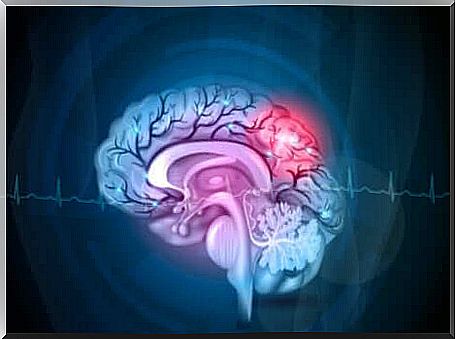Do You Know The Difference Between Brain And Mind?
Knowing the difference between the brain and the mind will help us to know ourselves better. Even though the two are closely related, they perform different functions. Do you want to know more about it?

You need to know the difference between brain and mind because many people tend to confuse them, in addition to ignoring the precise functions of each.
If we divide our being into a tangible reality and a non-tangible reality, our brain would be in the tangible space, the one we can observe. Our mind, for its part, would occupy the space of the non-tangible, the one we cannot touch.
The truth is, as human beings we are complex. Studies report that our nervous system is made up of 100,000 million neurons, all of which are interconnected. Other research also reveals the immense complexity of our brain, revealing amazing details.
For example, the skull protects the brain thanks to the bone cover. The brain weighs about 1.3 kg, and membranes and fluid surround it. It is thanks to our brains that we can feel, think and act in one way or another.
Difference between brain and mind
Now that we know these details, we can say that the brain is an organ, like the rest, and that it is possible to examine it. In contrast, the mind cannot be observed or touched. The neurons that are part of our brain help us make judgments, reason and shape our feelings to understand reality.
Our brain is made up of very important parts. These are the cerebellum, trunk and brain. It is also divided into two hemispheres, the right and the left. Each of these hemispheres consists of a frontal, temporal, parietal and occipital lobe.
What is known as “gray matter” is called the cerebral cortex and it is the outer part of the brain that allows us to perform the functions of thought. The cerebellum allows us to perform movements, no matter how complex, without our having to think about it.
Brain functions

This whole network makes our survival possible. Some important functions performed by our brain are as follows:
- It regulates vital functions: such as temperature, breathing, blood pressure, sleeping, eating, among others.
- It receives information from the senses: then it processes it, integrates it and interprets what it perceives through taste, hearing, sight, smell and touch.
- In addition, it develops the world of our emotions and behaviors.
- It controls our movements, such as running, walking, talking, among others.
- Thanks to the brain, we can think, feel, reason.
- It allows us to perform advanced cognitive functions, such as perception, memory, and learning.
All of this makes us wonder how the mind and the brain interact, or how they are related.
Relationship between brain and mind
Now that we know their differences and know that the brain is a physical organ that can be studied, seen and touched, unlike the mind, it is important to know how they relate or work together.
The work that the brain and the mind do is truly wonderful. For example, if we want to reach an object, we think about it, the brain receives this signal from our mind, activates the necessary nerves and the arm performs the movements.
We conceive of the thoughts in our mind, but it is with the help of the brain that the work or process is done on the physical plane.
Our spirit makes us unique

An incredible detail is that all animals are born with the resources they need to survive, and the majority act instinctively. Nevertheless, human beings are differentiated from the rest of animals by the mental processes that they can perform.
The brains of other animals are small, they perform basic tasks in order to survive. Its operation is rudimentary and actions obey stimuli. We humans have minds and perform processes both consciously and unconsciously.
Our mind helps us analyze thoughts and interpret data; we can even build beliefs and integrate them into our conscious or unconscious world.
Our brains and minds are awesome. Their tasks are just as incredible. They work together and, thanks to them, we can use our intuition, our imagination, our perception, our concentration, among others.
However, as we have seen, they have their differences and we must take them into account when we talk about them. Interesting, isn’t it?









